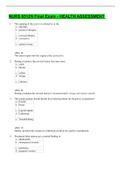Samenvatting
Complete summary health economics week 2
- Instelling
- Vrije Universiteit Amsterdam (VU)
- Boek
- Health Economics
This summary is a complete summary from the second week of health economics: Health policy and Health financing. It covers the book Health Economics by Jay Bhattacharya, chapter 16.
[Meer zien]














